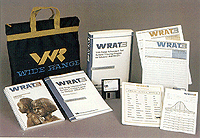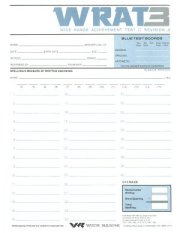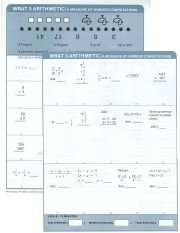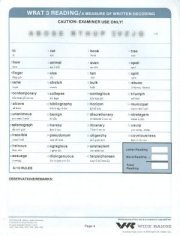| | Format: The WRAT III is a very brief screening measure for achievement. It covers reading recognition, spelling, and arithmetic. You choose a form and give it to all subjects. There are Blue, Tan, and Combined forms, and norms for each. It takes 15 to 30 minutes to administer and follows The 5/10 Rule. It contains very easy beginning items (letter reading, basic counting, and dictation of letters) followed by spelling, pronouncing words, and written math problems. Clients age 5 to 7 must start with the easy items. Clients age 8 or older can start with the harder items, but must pass the first 5; if they don't, you have to give the easy items to them (The 5 Rule). Administer items in consecutive order until 10 in a row are missed (The 10 Rule). It provides standard scores you can compare to IQ scores if you like, and grade equivalents.
Use and Ages: Brief, brief screening measure for achievement. Since it does not include reading comprehension, you can not use it to diagnose learning disabilities. Good for ages 5 through 75, with norms for small age ranges at younger ages and larger ranges for adults. Grade equivalents are tricky, because one or two points difference can make a large grade difference, and some grade levels are interpolated.
Norming Information: The test makers gathered 4433 clients from 23 age groups across 4 regions of the US, 13.6% Black, 10.7% Hispanic (English speaking), and 3.9% Other (people from Otheria). They attempted to match the 1990 census data.
Reliability and Validity Data: Internal consistencies are very high (would you expect otherwise?). Median alternate forms reliability are above .89, and test-retest reliability is .91 or better. The samples, however, are smaller. Blue and Tan standard error of measurement for Reading and Spelling is 5, Arithmetic is 6. Thus, you are 68% confident that an obtained Arithmetic score is within +6 points, and 95% confident that it is within + 12 points.
As to validity, 1) raw scores increase with age, 2) Reading and Spelling are highly correlated, Arithmetic correlates poorly with the other two. Reading and Spelling correlate .65 to .72 with WISC III Verbal IQs. Correlations with Vocabulary are .64. Arithmetic correlates .65 to .74 with WISC III FSIQ, VIQ, and PIQ. Correlation with Arithmetic is only .66 with WISC III. WAIS III correlations are weaker. The numbers aren't so great, but then, it is unclear whether they should be great… Correlations to other achievement tests are in the .50s to .70s (California Achievement Test and Stanford Achievement Test) and .60s to .80s (California Test of Basic Skills).
Discriminate function analysis for LD, EMH, gifted, and normal children has a small sample, but passable classifications (gifted=85%, LD=72%, and EMH=85%) for all but normal children (56% of 111 children classified… just better than flipping a quarter).
Conclusions: Thus… it's not the best test out there, but for 15 to 30 minutes of your time, it's OK.
|




|